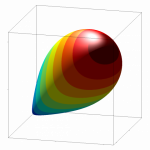In this post we will list built-in hypoplasticity formulations in the free Tochnog Professional program. Since these hypoplasticity options are built-in there is no need to link external umat routines. Moreover, in different areas of the domain different hypoplastic laws can be used (which might be troublesome when linking only one umat routine). For a more complete description of the different options please see the Tochnog Professional users manual. Different parts of this post are written by different experts in the field of hypoplasticity.
* Masin law: group_materi_plasti_hypo_masin, text by David Masin
The original clay hypoplastic model by Masin (2005). This model has been substituted by more recent version entitled as “Masin clay law”, but it is kept in the code for backward compatibility reasons.
* Masin clay law: group_materi_plasti_hypo_masin_clay, text by David Masin (https://soilmodels.com/hypoclay/)
Clay hypoplasticity model by Masin (2013). The implementation includes advanced features which may be optionally activated: stiffness anisotropy, rate effects (visco hypoplasticity), structure, intergranular strain, advanced model parameters controlling non-linearity. Model calibration may be done either through Tochnog Professional Incremental Driver (https://soilmodels.com/tochnogdriver/), ExCalibre (https://soilmodels.com/excalibre), Triax (https://soilmodels.com/triax), or element test drivers accepting umat formats.
* Wolffersdorff law: group_materi_plasti_hypo_wolffersdorff, text by Ivo Herle (https://soilmodels.com/hyposand/)
A basic hypoplastic model for granular soils (sand, gravel/rockfill). The model includes the critical state concept and thus it takes into account the impact of soil density and pressure level on the mechanical response (stiffness and shear strength). The model description can be found in von Wolffersdorff (1996). The calibration of the model parameters is described in Herle & Gudehus (1999). The model is not appropriate for the description of cyclic behavior. References:
von Wolffersdorff, P.-A. (1996). A hypoplastic relation for granular materials with a predefined limit state surface. Mechanics of Cohesive-Frictional Materials, 1, 251–271.
Herle, I., & Gudehus, G. (1999). Determination of parameters of a hypoplastic constitutive model from properties of grain assemblies. Mechanics of Cohesive-Frictional Materials, 4(5), 461–486.
* Wolffersdorff law extended Niemunis version: group_materi_plasti_hypo_niemunis, text by Andrzej Niemunis (http://www.pg.gda.pl/~aniem/pap-zips/habb-30-7-2003.pdf chapters 4.3.6 and 4.3.8)
* Niemunis visco law: group_materi_plasti_hypo_niemunis_visco, text by Andrzej Niemunis (http://www.pg.gda.pl/~aniem/pap-zips/habb-30-7-2003.pdf chapter 4.2)
a simple isotropic creep, relaxation and rate dependence (isotachs) with creep rate proportional to (1/OCR)^(1/Iv)
* Cohesion extension: group_materi_hypo_cohesion, text by Silvia Imposimato (http://www.tochnogprofessional.nl/manuals/user/user.pdf)
Hypoplasticity laws tend to be very nonlinear, especially when stresses are low. Think, by example, at stresses near a free surface. This nonlinearity may lead to troublesome iterative behavior in FE calculations. However, with this ‘cohesion extension’, you dictate the laws to be evaluated at a more compressive stress level, thus decreasing the amount on nonlinearity trouble in calculations.
* Intergranular strains extension: group_materi_plasti_hypo_strain_intergranular, text by Ivo Herle (https://soilmodels.com/hyposand/, https://soilmodels.com/hypoclay/)
A concept of intergranular strains, as an extension for the hypoplastic models, was proposed by Niemunis & Herle (1997) in order to incorporate a higher stiffness upon unloading and reloading, and thus to enable a realistic description of the cyclic behavior. The model parameters may be obtained from laboratory tests characterizing the small-strain-stiffness of soils. Reference:
Niemunis, A., & Herle, I. (1997). Hypoplastic model for cohesionless soils with elastic strain range. Mechanics of Cohesive-Frictional Materials, 2(4), 279–299.
* ISA – intergranular strains extension: group_materi_plasti_hypo_strain_isa, text by William Fuentes (https://soilmodels.com/isa/)
Hypoplastic models alone reproduce well the behavior of soils under monotonic loading, but fails to simulate its behavior upon cyclic loading. The Intergranular Strain Anisotropy (ISA) is a mathematical extension of conventional hypoplastic models for soils, proposed originally by Fuentes and Triantafyllidis (2015) to improve simulations of cyclic loading. It can be considered as a reformulation of the conventional intergranular strain theory by Niemunis and Herle (1997).
* minimum void ratio: group_materi_plasti_hypo_minimum_void_ratio, text by Silvia Imposimato (http://www.tochnogprofessional.nl/manuals/user/user.pdf)
Hypoplastic laws are very sensitive to the soil void ratio. In difficult calculations the calculated void ratio may become very law, due to nonlinearity or high local unbalance. This option limits the calculated void ratio to a specified value, thus preventing trouble in the hypoplasticity laws.
Extra options text by Dennis Roddeman (http://www.tochnogprofessional.nl/manuals/user/user.pdf)
For hypoplasticity additional options include OCR specification, full specification of initial state variables, full postprocessing in external programs, many example input files, well-tested in real world applications, etc.
Tags: Hypoplasticity Tochnog Professional Finite Elements




